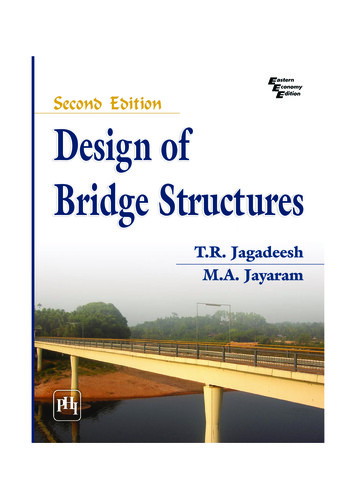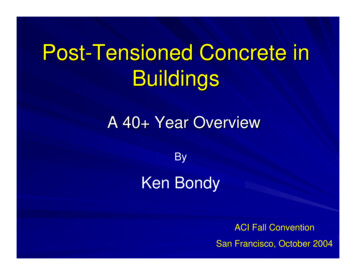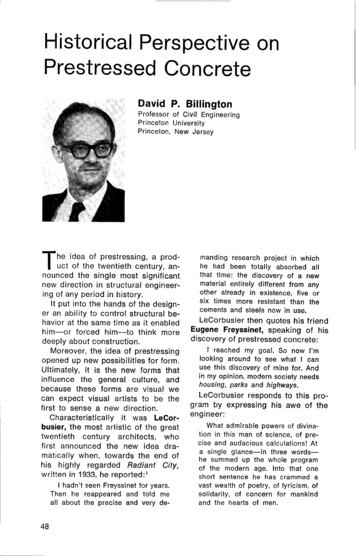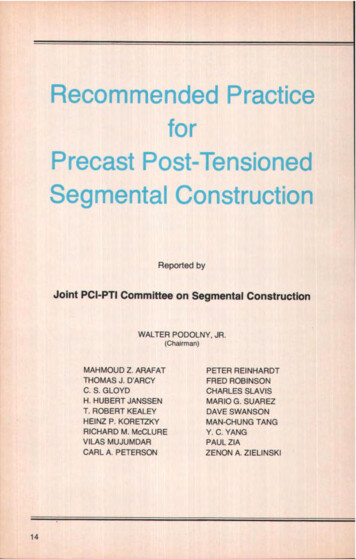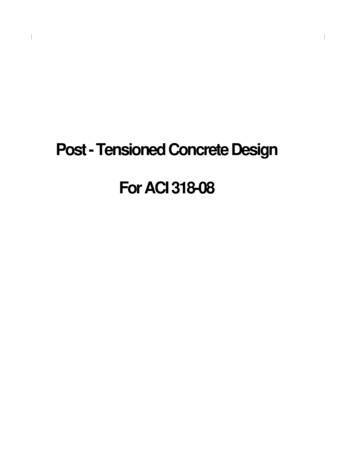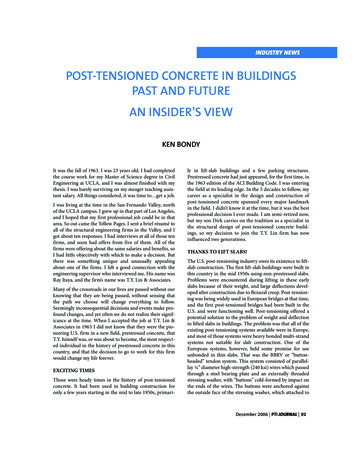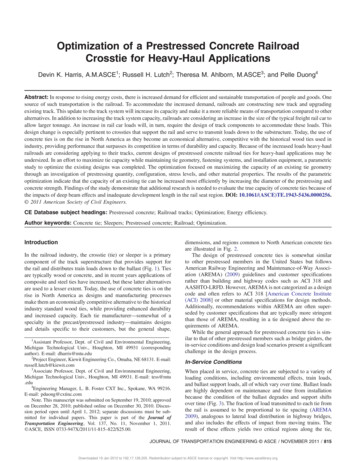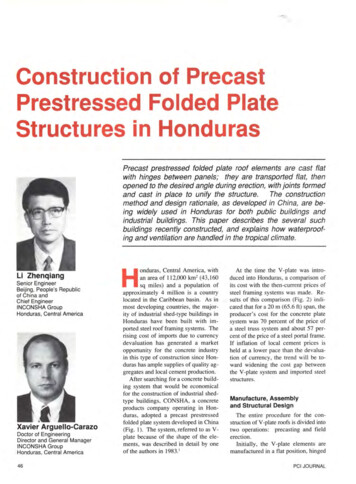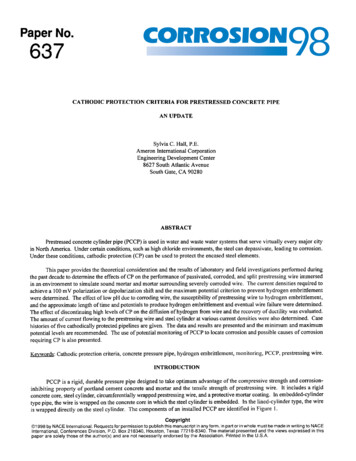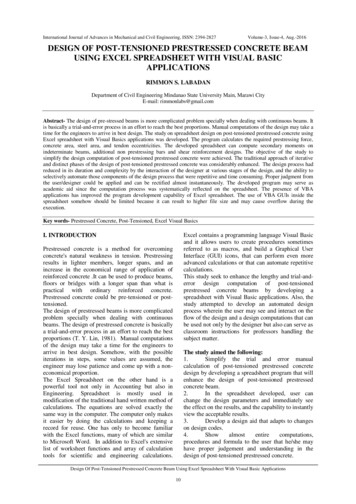
Transcription
International Journal of Advances in Mechanical and Civil Engineering, ISSN: 2394-2827Volume-3, Issue-4, Aug.-2016DESIGN OF POST-TENSIONED PRESTRESSED CONCRETE BEAMUSING EXCEL SPREADSHEET WITH VISUAL BASICAPPLICATIONSRIMMON S. LABADANDepartment of Civil Engineering Mindanao State University Main, Marawi CityE-mail: rimmonlabs@gmail.comAbstract- The design of pre-stressed beams is more complicated problem specially when dealing with continuous beams. Itis basically a trial-and-error process in an effort to reach the best proportions. Manual computations of the design may take atime for the engineers to arrive in best design. The study on spreadsheet design on post-tensioned prestressed concrete usingExcel spreadsheet with Visual Basics applications was developed. The program calculates the required prestressing force,concrete area, steel area, and tendon eccentricities. The developed spreadsheet can compute secondary moments onindeterminate beams, additional non prestressing bars and shear reinforcement designs. The objective of the study tosimplify the design computation of post-tensioned prestressed concrete were achieved. The traditional approach of iterativeand distinct phases of the design of post-tensioned prestressed concrete was considerably enhanced. The design process hadreduced in its duration and complexity by the interaction of the designer at various stages of the design, and the ability toselectively automate those components of the design process that were repetitive and time consuming. Proper judgment fromthe user/designer could be applied and can be rectified almost instantaneously. The developed program may serve asacademic aid since the computation process was systematically reflected on the spreadsheet. The presence of VBAapplications has improved the program development capability of Excel spreadsheet. The use of VBA GUIs inside thespreadsheet somehow should be limited because it can result to higher file size and may cause overflow during theexecution.Key words- Prestressed Concrete, Post-Tensioned, Excel Visual BasicsExcel contains a programming language Visual Basicand it allows users to create procedures sometimesreferred to as macros, and build a Graphical UserInterface (GUI) icons, that can perform even moreadvanced calculations or that can automate repetitivecalculations.This study seek to enhance the lengthy and trial-anderror design computation of post-tensionedprestressed concrete beams by developing aspreadsheet with Visual Basic applications. Also, thestudy attempted to develop an automated designprocess wherein the user may see and interact on theflow of the design and a design computations that canbe used not only by the designer but also can serve asclassroom instructions for professors handling thesubject matter.I. INTRODUCTIONPrestressed concrete is a method for overcomingconcrete's natural weakness in tension. Prestressingresults in lighter members, longer spans, and anincrease in the economical range of application ofreinforced concrete .It can be used to produce beams,floors or bridges with a longer span than what ispractical with ordinary reinforced concrete.Prestressed concrete could be pre-tensioned or posttensioned.The design of prestressed beams is more complicatedproblem specially when dealing with continuousbeams. The design of prestressed concrete is basicallya trial-and-error process in an effort to reach the bestproportions (T. Y. Lin, 1981). Manual computationsof the design may take a time for the engineers toarrive in best design. Somehow, with the possibleiterations in steps, some values are assumed, theengineer may lose patience and come up with a noneconomical proportion.The Excel Spreadsheet on the other hand is apowerful tool not only in Accounting but also inEngineering. Spreadsheet is mostly used inmodification of the traditional hand written method ofcalculations. The equations are solved exactly thesame way in the computer. The computer only makesit easier by doing the calculations and keeping arecord for reuse. One has only to become familiarwith the Excel functions, many of which are similarto Microsoft Word. In addition to Excel's extensivelist of worksheet functions and array of calculationtools for scientific and engineering calculations.The study aimed the following:1.Simplify the trial and error manualcalculation of post-tensioned prestressed concretedesign by developing a spreadsheet program that willenhance the design of post-tensioned prestressedconcrete beam.2.In the spreadsheet developed, user canchange the design parameters and immediately seethe effect on the results, and the capability to instantlyview the acceptable results.3.Develop a design aid that adapts to changeson design codes.4.Showalmostentirecomputations,procedures and formula to the user that he/she mayhave proper judgement and understanding in thedesign of post-tensioned prestressed concrete.Design Of Post-Tensioned Prestressed Concrete Beam Using Excel Spreadsheet With Visual Basic Applications10
International Journal of Advances in Mechanical and Civil Engineering, ISSN: 2394-28275.Develop a design aid that can be used forclassroom instructions.6.Take advantages of the capabilities of totoday’s spreadsheet specifically MS Excel 2013spreadsheet in the design of post tension prestressedconcrete. The lengthy and trial-and-error computationwill be simplified by simple clicks of Graphic UserInterface (GUI) through Visual Basic which isembedded in today’s MS Excel software and bysimply scrolling the spreadsheet to easily go back tothe inputted parameters that needs to be rectified.The following were the set limitations of thedeveloped spreadsheet.1.Prestressing force are assumed constant allthroughout the tendon length.2.The program can only compute momentloads based on given distributed loads of beam onsimple span beams.3.For indeterminate beams, live load momentsand any service loads were input parameters from theuser.4.Critical points on shear design were all userdefined.5.Only practical tendon layout which iscompound parabolic drapes were available forcontinuous beams.6.Double shaped beams and unsymmetricalsections with respect to vertical axis were notconsidered.7.The spreadsheet was saved as MS Excel2013 Macros Enabled. Hence, it will run only to MSexcel with VBA applications.Volume-3, Issue-4, Aug.-2016Cross-section TypesBeam cross-section types available are shown in thefigure below. The sections were pre-drawn withcorresponding dimensions which requires an inputfrom the user. Only symmetrical sections wereconsidered.Figure 1 Beam Cross-sectionsTendon ProfilesThe program supports only four types of tendonprofile. Any of these tendon profile may be used buthas constraints on profile elevation at end-span of thebeam. For simple beam end-span profile elevationwas always assumed to be at the elevation of thecentroid of the concrete. For indeterminate beam onlycontinuous compound parabolic profile elevation wasavailable considering the practical and realisticelevation of tendon.II. METHODOLOGYProgram DescriptionThe program developed was a MS ExcelSpreadsheets with Visual Basics forms and macrosthat computes the required prestressing force for thegiven loads, tendon profile, concrete section andmaterial properties. It can check the adequacy of thedesign and can allow user to have trial-and-errorprocess and instantly see the effect on the designupon input change.Analysis MethodA constant force approach was used in the design oranalysis, in which the effective prestress force wasassumed to be constant throughout the member. Thisdesign employed the concept of moment distributionmethod in determining the secondary moment due toprestressing force. The concept of Elastic Design inprestressed concrete was used in flexural designwhile Ultimate Design concept was used for sheardesign.Design CodeThe user could choose from ACI, AASHTO, or PCICode in determining the maximum allowable stressesof concrete and Prestressing steel. The user could alsoaccept the suggested value or change the allowablestresses on his/her preferences.Figure 2 Tendon ProfilesProgramming of ProcedureThe programing platform was Microsoft Office 2013Professional Edition, specifically Excel. The analysiswere done through macros specially programmed forprestressed concrete design. The user may not see thestep by step computation but may follow through thenecessary step by step output reflected in thespreadsheet cells. Programing was done bydeveloping functions or formula inside the cell orusing the Visual Basic Editor. The latter was used onprocedures that are iterative or procedures cannot befound on Excel list of functions. Also for simplicityof programing, the Visual Basic Editor is morepreferable especially on cells that varies formula.Design Of Post-Tensioned Prestressed Concrete Beam Using Excel Spreadsheet With Visual Basic Applications11
International Journal of Advances in Mechanical and Civil Engineering, ISSN: 2394-2827Volume-3, Issue-4, Aug.-2016Software Development FlowchartThe design of Prestressed Concrete is generalized infollowing flowchart shown in the figure below. Theprocess differs on different design method used.Figure 5 Elastic Design Using Magnel DiagramFigure 3 General Flow Chart of Design of Post-TensionedConcrete BeamFigure 6 Elastic Design by T.Y. LinFigure 4 Elastic DesignDesign Of Post-Tensioned Prestressed Concrete Beam Using Excel Spreadsheet With Visual Basic Applications12
International Journal of Advances in Mechanical and Civil Engineering, ISSN: 2394-2827Volume-3, Issue-4, Aug.-2016The spreadsheet uses macros and Visual Basiclanguage programming and thereby saved as MacroEnabled Workbook. Thus, the user must click first the“Enable Content” Button located below the ribbon ofthe spreadsheet. Some program procedures run uponopening of the workbook, thus the user is suggestedto always enable the macros content of this program.Figure 8 Enabling Macros4.1.2Workbook LayoutFigure 4.1 shows the main program (sheet) view as itappears once it is opened. Design method to beselected appears on the active sheet name locatedbelow the sheet screen as shown in the figure markedby red annotations. The right side of the screen werenotes and suggestions. Notes and suggestions werenot be printable but will served as a guide and manualfor the user.Figure 7 Continuous BeamDebuggingJust like human creation, computer programs are lessthan perfect. A series of sample problems differentbooks were tried and compared in order to attain asatisfactory results and find out source code errors.Transferring files to other computer were also done todetect compatibility problems.III. RESULTS AND DISCUSSIONSGeneralThe developed spreadsheet program is capable ofcomputing for the design of post-tensionedprestressed concrete beam. It can give the requiredprestressing force, tendon eccentricities, and shearreinforcements based on the user’s preferences. Thespreadsheet program (workbook) is composed ofseven sheets. Each sheet contained one designmethod.Figure 9 Workbook LayoutsInput CellsThe cells of spreadsheet were protected. Only cellsallocated for user input can be edited. Input cells wereformatted green and italic fonts, and underlined whileoutput cells are italics and has a red color font.Output CellsThe output cellsare protected and cannot be altered.Output results were preliminary computations,prestressing force, tendon eccentricity, tendon profiletype, non-prestressing bars, and section properties. Asummary of all design output was formed on thelatter part of the program. A detailed step by stepcomputation with shown formula is shown for theuser to follow.1. Sheet 1 (Introduction)2. Sheet 2 (Elastic Design)3. Sheet 3 (Elastic Design by Magnel)4. Sheet 4 (Elastic Design by T.Y. Lin)5. Sheet 5 (Indeterminate Beam)6. Sheet 6 (Shear Design for Indeterminate Beam)7. Sheet 7 (Moment Distribution)Opening the WorkbookDesign Of Post-Tensioned Prestressed Concrete Beam Using Excel Spreadsheet With Visual Basic Applications13
International Journal of Advances in Mechanical and Civil Engineering, ISSN: 2394-2827Volume-3, Issue-4, Aug.-2016Design ExampleThe following series figure shown is an example ofbeam design using elastic design method.Figure 10 Detailed ComputationFigure 11 Graphical Method Magnel DiagramFigure 12 Design Output SummaryDesign Of Post-Tensioned Prestressed Concrete Beam Using Excel Spreadsheet With Visual Basic Applications14
International Journal of Advances in Mechanical and Civil Engineering, ISSN: 2394-2827Volume-3, Issue-4, Aug.-2016Design Of Post-Tensioned Prestressed Concrete Beam Using Excel Spreadsheet With Visual Basic Applications15
International Journal of Advances in Mechanical and Civil Engineering, ISSN: 2394-2827Volume-3, Issue-4, Aug.-2016were achieved. The traditional approach of iterativeand distinct phases of the design of post-tensionedprestressed concrete was considerably enhanced. Thedesign process had reduced in its duration andcomplexity by the interaction of the designer atvarious stages of the design, and the ability toselectively automate those components of the oper judgment from the user/designercould be applied and can be rectified almostinstantaneously. The developed program may serveas academic aid since the computation process wassystematically reflected on the spreadsheet.ACKNOWLEDGEMENTThe senior author would like to acknowledge theEngineering Research and Development forTechnology-Department of Science and Technology(ERDT-DOST) for the scholarship and researchgrants.REFERENCES[1]. ADAPT, “Post-Tensioned and Reinforced Concrete Slab andBeam Design Software ADAPT-PT/RC 2014”. Online. 2015http://www.adaptsoft.com/specs-pt.php[2]. American Concrete Institute (2008), Building CodeRequirements for Structural Concrete and Commentary. ,USA.[3]. Billo, E. Joseph (2007), Excel For Scientist and Engineers,John Wiley & Sons, Inc., Hoboken, New Jersey.[4]. Chou, Karen C. (2001), “Enhancing the Teaching of MomentDistribution Analysis Using Spreadsheet” ,2001 ASEESoutheast Section Conference.[5]. CSIAmerica, “Sap2000”. Online. December ome[6]. Nawy, Edward G. (2010), Prestressed Concrete: AFundamental Approach, Pearson Education Inc., New Jersey.[7]. Gerwick, Ben C. Jr.(1993), Construction of PrestressedConcrete Structure, John Wiley & Sons, Inc., New York.[8]. Lin, Tung-Yen (1981),Design of Prestressed ConcreteStructures Third Edition, John Wiley &Sons, Inc., NewYork.[9]. Microsoft. "How to use Visual Basic for Applications inExcel.”Online. 2015. [10]. Nelson, A. (1980), Design of Concrete Structures, McGrawHill Companies, Inc. New York.[11]. Precast/Prestressed Concrete Institute (1999), PCI DesignHandbook 5th Edition, USA.[12]. Shoemaker, W. Lee & Williams, Steve (1988), PrestressedConcrete Design[13]. Using Spreadsheets, PCI JOURNAL March-April 1988.[14]. Walkenbach, John (2007), Excel 2007 VBA ProgrammingFor Dummies ,[15]. Wiley Publishing, Inc., 111 River Street Hoboken, NJ 070305774.[16]. Webb, Jeff (1996),Using Excel Visual Basic forApplications Second Edition, Philippine Arts, Inc., 163Tandang Sora St., Caloocan City.IV. SUMMARY, CONCLUSIONS, ANDRECOMMENDATIONSThe study on spreadsheet design on post-tensionedprestressed concrete using Excel spreadsheet withvisual basis applications was developed. The programrequires the user to input loads, dimensions, anddesign codes, and material properties. The programthen calculates the required prestressing force,concrete area, steel area, and tendon eccentricities.The developed spreadsheet can compute secondarymoments on indeterminate beams, additional nonprestressing bars and shear reinforcement designs.The objective of the study to simplify the designcomputation of post-tensioned prestressed concrete Design Of Post-Tensioned Prestressed Concrete Beam Using Excel Spreadsheet With Visual Basic Applications16
Figure 9 Workbook Layouts Input Cells The cells of spreadsheet were protected. Only cells allocated for user input can be edited. Input cells were formatted green and italic fonts, and underlined while output cells are italics and has a red color font. Output C
